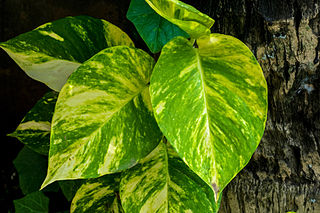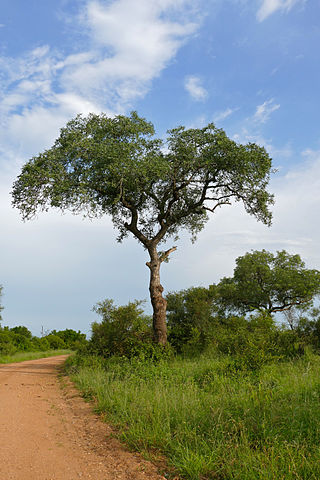
Epipremnum aureum is a species in the arum family Araceae, native to Mo'orea in the Society Islands of French Polynesia. The species is a popular houseplant in temperate regions but has also become naturalised in tropical and sub-tropical forests worldwide, including northern South Africa, Australia, Southeast Asia, South Asia, the Pacific Islands and the West Indies, where it has caused severe ecological damage in some cases.

Epimedium, also known as barrenwort, bishop's hat, fairy wings, horny goat weed, or yin yang huo, is a genus of flowering plants in the family Berberidaceae. The majority of the species are endemic to China, with smaller numbers elsewhere in Asia, and a few in the Mediterranean region.

Brachypodium pinnatum, the heath false brome or tor-grass, is a species of grass with a widespread distribution in temperate regions of the Northern Hemisphere. It typically grows in calcareous grassland, and reaches 70–120 centimetres (28–47 in) tall. The flowerhead is open, with 10 to 15 erect spikelets.

Alloxylon is a genus of four species in the family Proteaceae of mainly small to medium-sized trees. They are native to the eastern coast of Australia, with one species, A. brachycarpum found in New Guinea and the Aru Islands. The genus is a relatively new creation, being split off from Oreocallis in 1991. The name is derived from Ancient Greek allo- "other" or "strange" and xylon or "wood" due to their unusual cell architecture compared with the related genera Telopea and Oreocallis. In Australia, they are known as tree waratahs due to similarities in the inflorescences between them and the closely related Telopea.

The Puerto Princesa Subterranean River National Park is a protected area in the Philippines.

West Yatton Down is a 14.4 hectare biological Site of Special Scientific Interest in Wiltshire, notified in 1971.

Epipremnum pinnatum is a species of flowering plant in the family Araceae. It has many common names, including centipede tongavine and dragon-tail plant. In the Philippines, it is known in Tagalog as tibatib.

Kalanchoe pinnata, commonly known as cathedral bells, air plant, life plant, miracle leaf, and Goethe plant is a succulent plant native to Madagascar. It is a popular houseplant and has become naturalized in tropical and subtropical areas. The species is distinctive for the profusion of miniature plantlets that form on the margins of its leaves, a trait it has in common with some other members of Bryophyllum.

Heterosperma is a genus of flowering plants in the sunflower family, native to North and South America.

Alloxylon pinnatum, known as Dorrigo waratah, is a tree of the family Proteaceae found in warm-temperate rainforest of south-east Queensland and northern New South Wales in eastern Australia. It has shiny green leaves that are either pinnate (lobed) and up to 30 cm (12 in) long, or lanceolate (spear-shaped) and up to 15 cm (5.9 in) long. The prominent pinkish-red flower heads, known as inflorescences, appear in spring and summer; these are made up of 50 to 140 individual flowers arranged in corymb or raceme. These are followed by rectangular woody seed pods, which bear two rows of winged seeds.

Aketajawe-Lolobata National Park is a national park on Halmahera, the biggest island in the North Maluku province of Indonesia. The park is considered by BirdLife International to be vital for the survival of at least 23 endemic bird species. Aketajawe-Lolobata, which has an area of 167,300 hectares, was declared a national park in 2004.

Heterosperma pinnatum, the wingpetal, is a New World species of plants in the sunflower family. It has a discontinuous distribution in North and South America, having been found in Bolivia, Venezuela, Mexico, Guatemala, Honduras, and the south-western United States,

Spondiadoideae is a plant subfamily in the cashew and sumac family Anacardiaceae.

Zanthoxylum pinnatum, commonly known as yellow wood, is a species of flowering plant of the family Rutaceae native to Lord Howe and Norfolk Islands. It is a tree with pinnate leaves, white male and female flowers arranged in groups in leaf axils, and spherical, purple follicles containing a single black seed.

Epimedium pinnatum is a species of flowering plant in the barberry family Berberidaceae, native to northern Iran. It is a slowly-spreading evergreen perennial growing to 30 cm (12 in) tall and broad, with oval hairy leaves and bright yellow spurred flowers in late spring and early summer.
Tapeinidium is a genus of ferns in the family Lindsaeaceae with about 19 species. Species are native to south-eastern Asia, from Thailand to New Guinea, and into the western Pacific. Tapeinidium pinnatum has been introduced into India.

Myriophyllum pinnatum, common names cutleaf water-milfoil, green parrot's-feather, and pinnate water-milfoil, is a species of Myriophyllum.
Koordersiodendron is a monotypic genus of flowering plants belonging to the family Anacardiaceae. It only contains one known species, Koordersiodendron pinnatum(Blanco) Merr.

Epipremnum amplissimum is a species of flowering plant in the genus Epipremnum. native to Southeast Asia, from New Guinea to Vanuatu including northern Australia.
Sijfert Hendrik Koorders was a Dutch botanist, who worked primarily on the flora of Java.

















